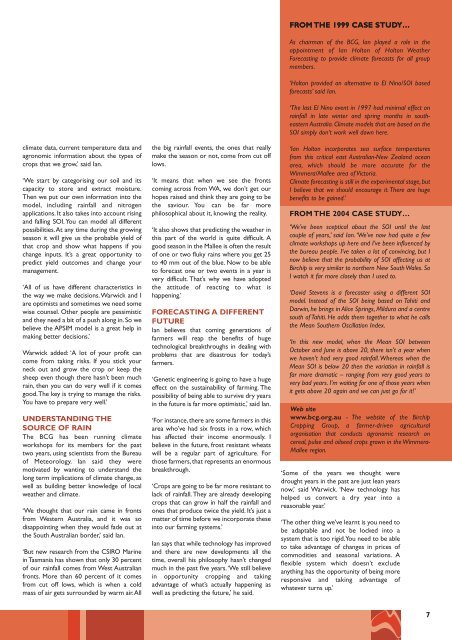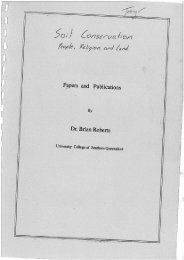Masters of the Climate: Innovative farmers ... - South West NRM
Masters of the Climate: Innovative farmers ... - South West NRM
Masters of the Climate: Innovative farmers ... - South West NRM
You also want an ePaper? Increase the reach of your titles
YUMPU automatically turns print PDFs into web optimized ePapers that Google loves.
climate data, current temperature data and<br />
agronomic information about <strong>the</strong> types <strong>of</strong><br />
crops that we grow,’ said Ian.<br />
‘We start by categorising our soil and its<br />
capacity to store and extract moisture.<br />
Then we put our own information into <strong>the</strong><br />
model, including rainfall and nitrogen<br />
applications. It also takes into account rising<br />
and falling SOI. You can model all different<br />
possibilities.At any time during <strong>the</strong> growing<br />
season it will give us <strong>the</strong> probable yield <strong>of</strong><br />
that crop and show what happens if you<br />
change inputs. It’s a great opportunity to<br />
predict yield outcomes and change your<br />
management.<br />
‘All <strong>of</strong> us have different characteristics in<br />
<strong>the</strong> way we make decisions.Warwick and I<br />
are optimists and sometimes we need some<br />
wise counsel. O<strong>the</strong>r people are pessimistic<br />
and <strong>the</strong>y need a bit <strong>of</strong> a push along in. So we<br />
believe <strong>the</strong> APSIM model is a great help in<br />
making better decisions.’<br />
Warwick added: ‘A lot <strong>of</strong> your pr<strong>of</strong>it can<br />
come from taking risks. If you stick your<br />
neck out and grow <strong>the</strong> crop or keep <strong>the</strong><br />
sheep even though <strong>the</strong>re hasn’t been much<br />
rain, <strong>the</strong>n you can do very well if it comes<br />
good.The key is trying to manage <strong>the</strong> risks.<br />
You have to prepare very well.’<br />
UNDERSTANDING THE<br />
SOURCE OF RAIN<br />
The BCG has been running climate<br />
workshops for its members for <strong>the</strong> past<br />
two years, using scientists from <strong>the</strong> Bureau<br />
<strong>of</strong> Meteorology. Ian said <strong>the</strong>y were<br />
motivated by wanting to understand <strong>the</strong><br />
long term implications <strong>of</strong> climate change, as<br />
well as building better knowledge <strong>of</strong> local<br />
wea<strong>the</strong>r and climate.<br />
‘We thought that our rain came in fronts<br />
from <strong>West</strong>ern Australia, and it was so<br />
disappointing when <strong>the</strong>y would fade out at<br />
<strong>the</strong> <strong>South</strong> Australian border,’ said Ian.<br />
‘But new research from <strong>the</strong> CSIRO Marine<br />
in Tasmania has shown that only 30 percent<br />
<strong>of</strong> our rainfall comes from <strong>West</strong> Australian<br />
fronts. More than 60 percent <strong>of</strong> it comes<br />
from cut <strong>of</strong>f lows, which is when a cold<br />
mass <strong>of</strong> air gets surrounded by warm air.All<br />
<strong>the</strong> big rainfall events, <strong>the</strong> ones that really<br />
make <strong>the</strong> season or not, come from cut <strong>of</strong>f<br />
lows.<br />
‘It means that when we see <strong>the</strong> fronts<br />
coming across from WA, we don’t get our<br />
hopes raised and think <strong>the</strong>y are going to be<br />
<strong>the</strong> saviour. You can be far more<br />
philosophical about it, knowing <strong>the</strong> reality.<br />
‘It also shows that predicting <strong>the</strong> wea<strong>the</strong>r in<br />
this part <strong>of</strong> <strong>the</strong> world is quite difficult. A<br />
good season in <strong>the</strong> Mallee is <strong>of</strong>ten <strong>the</strong> result<br />
<strong>of</strong> one or two fluky rains where you get 25<br />
to 40 mm out <strong>of</strong> <strong>the</strong> blue. Now to be able<br />
to forecast one or two events in a year is<br />
very difficult. That’s why we have adopted<br />
<strong>the</strong> attitude <strong>of</strong> reacting to what is<br />
happening.’<br />
FORECASTING A DIFFERENT<br />
FUTURE<br />
Ian believes that coming generations <strong>of</strong><br />
<strong>farmers</strong> will reap <strong>the</strong> benefits <strong>of</strong> huge<br />
technological breakthroughs in dealing with<br />
problems that are disastrous for today’s<br />
<strong>farmers</strong>.<br />
‘Genetic engineering is going to have a huge<br />
effect on <strong>the</strong> sustainability <strong>of</strong> farming. The<br />
possibility <strong>of</strong> being able to survive dry years<br />
in <strong>the</strong> future is far more optimistic,’ said Ian.<br />
‘For instance, <strong>the</strong>re are some <strong>farmers</strong> in this<br />
area who’ve had six frosts in a row, which<br />
has affected <strong>the</strong>ir income enormously. I<br />
believe in <strong>the</strong> future, frost resistant wheats<br />
will be a regular part <strong>of</strong> agriculture. For<br />
those <strong>farmers</strong>, that represents an enormous<br />
breakthrough.<br />
‘Crops are going to be far more resistant to<br />
lack <strong>of</strong> rainfall. They are already developing<br />
crops that can grow in half <strong>the</strong> rainfall and<br />
ones that produce twice <strong>the</strong> yield. It’s just a<br />
matter <strong>of</strong> time before we incorporate <strong>the</strong>se<br />
into our farming systems.’<br />
Ian says that while technology has improved<br />
and <strong>the</strong>re are new developments all <strong>the</strong><br />
time, overall his philosophy hasn’t changed<br />
much in <strong>the</strong> past five years.‘We still believe<br />
in opportunity cropping and taking<br />
advantage <strong>of</strong> what’s actually happening as<br />
well as predicting <strong>the</strong> future,’ he said.<br />
FROM THE 1999 CASE STUDY…<br />
As chairman <strong>of</strong> <strong>the</strong> BCG, Ian played a role in <strong>the</strong><br />
appointment <strong>of</strong> Ian Holton <strong>of</strong> Holton Wea<strong>the</strong>r<br />
Forecasting to provide climate forecasts for all group<br />
members.<br />
‘Holton provided an alternative to El Nino/SOI based<br />
forecasts’ said Ian.<br />
‘The last El Nino event in 1997 had minimal effect on<br />
rainfall in late winter and spring months in sou<strong>the</strong>astern<br />
Australia. <strong>Climate</strong> models that are based on <strong>the</strong><br />
SOI simply don’t work well down here.<br />
‘Ian Holton incorporates sea surface temperatures<br />
from this critical east Australian-New Zealand ocean<br />
area, which should be more accurate for <strong>the</strong><br />
Wimmera/Mallee area <strong>of</strong> Victoria.<br />
<strong>Climate</strong> forecasting is still in <strong>the</strong> experimental stage, but<br />
I believe that we should encourage it. There are huge<br />
benefits to be gained.’<br />
FROM THE 2004 CASE STUDY…<br />
‘We’ve been sceptical about <strong>the</strong> SOI until <strong>the</strong> last<br />
couple <strong>of</strong> years,’ said Ian. ‘We’ve now had quite a few<br />
climate workshops up here and I’ve been influenced by<br />
<strong>the</strong> bureau people. I’ve taken a lot <strong>of</strong> convincing, but I<br />
now believe that <strong>the</strong> probability <strong>of</strong> SOI affecting us at<br />
Birchip is very similar to nor<strong>the</strong>rn New <strong>South</strong> Wales. So<br />
I watch it far more closely than I used to.<br />
‘David Stevens is a forecaster using a different SOI<br />
model. Instead <strong>of</strong> <strong>the</strong> SOI being based on Tahiti and<br />
Darwin, he brings in Alice Springs, Mildura and a centre<br />
south <strong>of</strong> Tahiti. He adds <strong>the</strong>m toge<strong>the</strong>r to what he calls<br />
<strong>the</strong> Mean Sou<strong>the</strong>rn Oscillation Index.<br />
‘In this new model, when <strong>the</strong> Mean SOI between<br />
October and June is above 20, <strong>the</strong>re isn’t a year when<br />
we haven’t had very good rainfall. Whereas when <strong>the</strong><br />
Mean SOI is below 20 <strong>the</strong>n <strong>the</strong> variation in rainfall is<br />
far more dramatic – ranging from very good years to<br />
very bad years. I’m waiting for one <strong>of</strong> those years when<br />
it gets above 20 again and we can just go for it!’<br />
Web site<br />
www.bcg.org.au - The website <strong>of</strong> <strong>the</strong> Birchip<br />
Cropping Group, a farmer-driven agricultural<br />
organisation that conducts agronomic research on<br />
cereal, pulse and oilseed crops grown in <strong>the</strong> Wimmera-<br />
Mallee region.<br />
‘Some <strong>of</strong> <strong>the</strong> years we thought were<br />
drought years in <strong>the</strong> past are just lean years<br />
now,’ said Warwick. ‘New technology has<br />
helped us convert a dry year into a<br />
reasonable year.’<br />
‘The o<strong>the</strong>r thing we’ve learnt is you need to<br />
be adaptable and not be locked into a<br />
system that is too rigid.You need to be able<br />
to take advantage <strong>of</strong> changes in prices <strong>of</strong><br />
commodities and seasonal variations. A<br />
flexible system which doesn’t exclude<br />
anything has <strong>the</strong> opportunity <strong>of</strong> being more<br />
responsive and taking advantage <strong>of</strong><br />
whatever turns up.’<br />
7
















